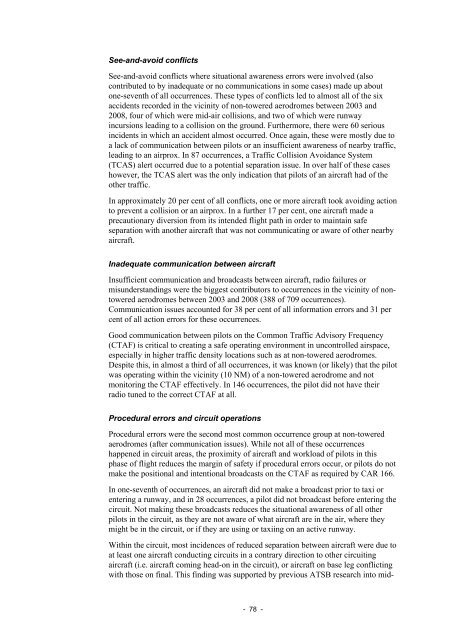Safety in the vicinity of non-towered aerodromes - Australian ...
Safety in the vicinity of non-towered aerodromes - Australian ...
Safety in the vicinity of non-towered aerodromes - Australian ...
Create successful ePaper yourself
Turn your PDF publications into a flip-book with our unique Google optimized e-Paper software.
See-and-avoid conflicts<br />
See-and-avoid conflicts where situational awareness errors were <strong>in</strong>volved (also<br />
contributed to by <strong>in</strong>adequate or no communications <strong>in</strong> some cases) made up about<br />
one-seventh <strong>of</strong> all occurrences. These types <strong>of</strong> conflicts led to almost all <strong>of</strong> <strong>the</strong> six<br />
accidents recorded <strong>in</strong> <strong>the</strong> vic<strong>in</strong>ity <strong>of</strong> <strong>non</strong>-<strong>towered</strong> <strong>aerodromes</strong> between 2003 and<br />
2008, four <strong>of</strong> which were mid-air collisions, and two <strong>of</strong> which were runway<br />
<strong>in</strong>cursions lead<strong>in</strong>g to a collision on <strong>the</strong> ground. Fur<strong>the</strong>rmore, <strong>the</strong>re were 60 serious<br />
<strong>in</strong>cidents <strong>in</strong> which an accident almost occurred. Once aga<strong>in</strong>, <strong>the</strong>se were mostly due to<br />
a lack <strong>of</strong> communication between pilots or an <strong>in</strong>sufficient awareness <strong>of</strong> nearby traffic,<br />
lead<strong>in</strong>g to an airprox. In 87 occurrences, a Traffic Collision Avoidance System<br />
(TCAS) alert occurred due to a potential separation issue. In over half <strong>of</strong> <strong>the</strong>se cases<br />
however, <strong>the</strong> TCAS alert was <strong>the</strong> only <strong>in</strong>dication that pilots <strong>of</strong> an aircraft had <strong>of</strong> <strong>the</strong><br />
o<strong>the</strong>r traffic.<br />
In approximately 20 per cent <strong>of</strong> all conflicts, one or more aircraft took avoid<strong>in</strong>g action<br />
to prevent a collision or an airprox. In a fur<strong>the</strong>r 17 per cent, one aircraft made a<br />
precautionary diversion from its <strong>in</strong>tended flight path <strong>in</strong> order to ma<strong>in</strong>ta<strong>in</strong> safe<br />
separation with ano<strong>the</strong>r aircraft that was not communicat<strong>in</strong>g or aware <strong>of</strong> o<strong>the</strong>r nearby<br />
aircraft.<br />
Inadequate communication between aircraft<br />
Insufficient communication and broadcasts between aircraft, radio failures or<br />
misunderstand<strong>in</strong>gs were <strong>the</strong> biggest contributors to occurrences <strong>in</strong> <strong>the</strong> vic<strong>in</strong>ity <strong>of</strong> <strong>non</strong><strong>towered</strong><br />
<strong>aerodromes</strong> between 2003 and 2008 (388 <strong>of</strong> 709 occurrences).<br />
Communication issues accounted for 38 per cent <strong>of</strong> all <strong>in</strong>formation errors and 31 per<br />
cent <strong>of</strong> all action errors for <strong>the</strong>se occurrences.<br />
Good communication between pilots on <strong>the</strong> Common Traffic Advisory Frequency<br />
(CTAF) is critical to creat<strong>in</strong>g a safe operat<strong>in</strong>g environment <strong>in</strong> uncontrolled airspace,<br />
especially <strong>in</strong> higher traffic density locations such as at <strong>non</strong>-<strong>towered</strong> <strong>aerodromes</strong>.<br />
Despite this, <strong>in</strong> almost a third <strong>of</strong> all occurrences, it was known (or likely) that <strong>the</strong> pilot<br />
was operat<strong>in</strong>g with<strong>in</strong> <strong>the</strong> vic<strong>in</strong>ity (10 NM) <strong>of</strong> a <strong>non</strong>-<strong>towered</strong> aerodrome and not<br />
monitor<strong>in</strong>g <strong>the</strong> CTAF effectively. In 146 occurrences, <strong>the</strong> pilot did not have <strong>the</strong>ir<br />
radio tuned to <strong>the</strong> correct CTAF at all.<br />
Procedural errors and circuit operations<br />
Procedural errors were <strong>the</strong> second most common occurrence group at <strong>non</strong>-<strong>towered</strong><br />
<strong>aerodromes</strong> (after communication issues). While not all <strong>of</strong> <strong>the</strong>se occurrences<br />
happened <strong>in</strong> circuit areas, <strong>the</strong> proximity <strong>of</strong> aircraft and workload <strong>of</strong> pilots <strong>in</strong> this<br />
phase <strong>of</strong> flight reduces <strong>the</strong> marg<strong>in</strong> <strong>of</strong> safety if procedural errors occur, or pilots do not<br />
make <strong>the</strong> positional and <strong>in</strong>tentional broadcasts on <strong>the</strong> CTAF as required by CAR 166.<br />
In one-seventh <strong>of</strong> occurrences, an aircraft did not make a broadcast prior to taxi or<br />
enter<strong>in</strong>g a runway, and <strong>in</strong> 28 occurrences, a pilot did not broadcast before enter<strong>in</strong>g <strong>the</strong><br />
circuit. Not mak<strong>in</strong>g <strong>the</strong>se broadcasts reduces <strong>the</strong> situational awareness <strong>of</strong> all o<strong>the</strong>r<br />
pilots <strong>in</strong> <strong>the</strong> circuit, as <strong>the</strong>y are not aware <strong>of</strong> what aircraft are <strong>in</strong> <strong>the</strong> air, where <strong>the</strong>y<br />
might be <strong>in</strong> <strong>the</strong> circuit, or if <strong>the</strong>y are us<strong>in</strong>g or taxi<strong>in</strong>g on an active runway.<br />
With<strong>in</strong> <strong>the</strong> circuit, most <strong>in</strong>cidences <strong>of</strong> reduced separation between aircraft were due to<br />
at least one aircraft conduct<strong>in</strong>g circuits <strong>in</strong> a contrary direction to o<strong>the</strong>r circuit<strong>in</strong>g<br />
aircraft (i.e. aircraft com<strong>in</strong>g head-on <strong>in</strong> <strong>the</strong> circuit), or aircraft on base leg conflict<strong>in</strong>g<br />
with those on f<strong>in</strong>al. This f<strong>in</strong>d<strong>in</strong>g was supported by previous ATSB research <strong>in</strong>to mid-<br />
- 78 -
















